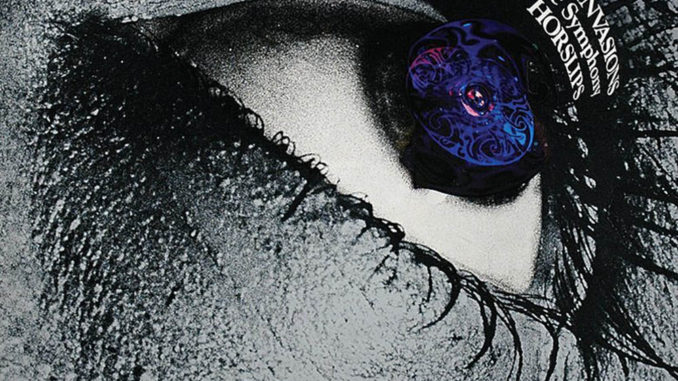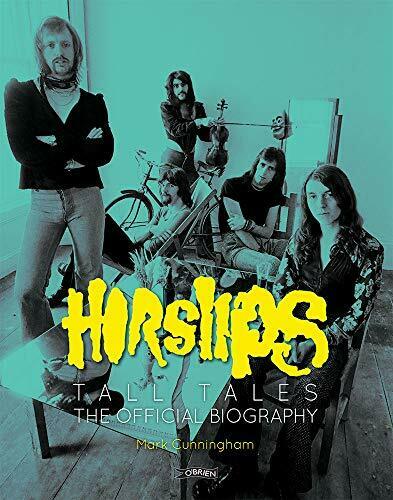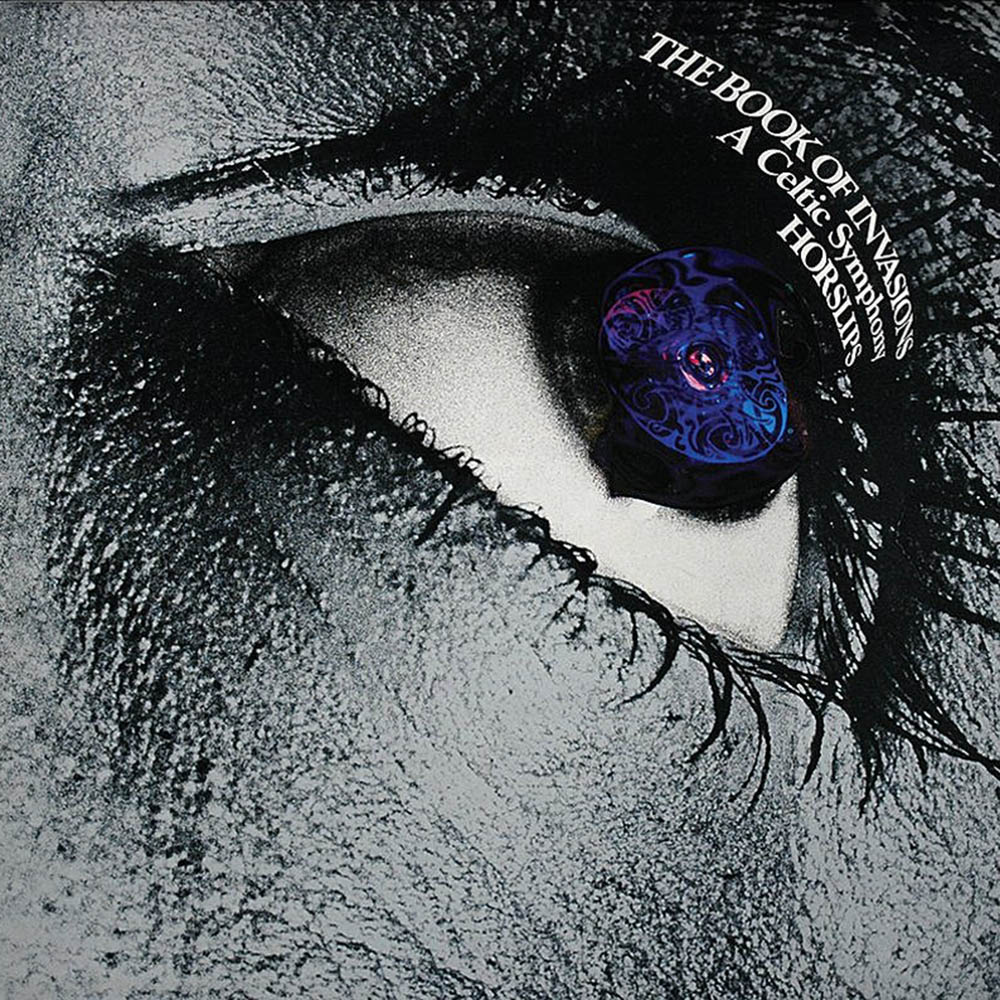
Horslips are an Irish rock band with Celtic and folk influences. They were initially active as a touring and recording band from 1970-1980. After decades apart, they reunited very sporadically for gigs in the 2000s, and fairly regularly since 2009.
They were the first band who made a whole-hearted attempt at mixing their Irish folk music heritage with modern rock music. They would mix traditional Irish airs, jigs, and reels with guitar-based rock music. The music and arrangements are frequently technically of a high standard, and especially for the first half of their recording career often contained a 1970s progressive flair.
The group are regarded as founding fathers of Celtic rock. Others would dabble in it too, of course, like fellow Irishmen Thin Lizzy who had a hit with a rocked-up version of the traditional folk tune Whiskey In the Jar in 1972. Like most others, though, they did not go all-in in that direction. Horslips on the other hand did.
On 12 November 1976 Horslips released their sixth studio album, often hailed as their magnum opus: The Book of Invasions: A Celtic Symphony. This is a concept album where the band adapted Irish legends and built them into a complex story. Most of these legends come from the Lebor Gabála Érenn, a book of Irish mythology (known as ‘The Book of Invasions’ in English).
Additionally, the album would became the first of a trilogy of albums about the lives of the Irish people. The Book of Invasions was about the folk at home – the people, the legends of the land, the hardships endured, and what it all led to. This was followed by Aliens (1977), which took a closer look at the Irish who was forced to leave their native land behind for new opportunities in the west. The trilogy was completed with The Man Who Built America (1978) – the story of how Irish people have fared in foreign lands. Each of those concepts would have been ambitious enough onto themselves, but presenting them as a trilogy elevates all parts of the concept that much more. No rock band had ever taken on such an ambitious telling of the story of their countrymen before.
For now, we are going to look closer at the first of those albums, and in particular the song Ride To Hell. For such a strong conceptual piece, it helps to look at songs in context of the larger work they are part of to fully understand them.
In the old Ireland there were three principal categories of song, and The Book of Invasions album is divided into three movements based on these: The first batch of songs are referred to as “Geantraí” (joyful music), then we have “Goltraí (lament/sorrowful music), and finally Suantraí (lullaby). These categories should not be taken at face value, because the first full song in the “joyful” category is Trouble (With A Capital T). Happy title, right? The song is however quite the barnstormer musically, and one of the band’s best known and most popular songs, so in that sense it can definitely be referred to as joyful.

Horslips had written about Irish mythology before, especially on their second album The Tain (1973), but this time they wanted to focus on the people. “The Book of Invasions was about the genesis of the Irish race,” said drummer/lyricist Eamon Carr in the excellent official Horslips biography written by Mark Cunningham. “We ran shy of it for a while, thinking that it would be outrageous – that we couldn’t do that. But that feeling gave way to, ‘Aw, feck it, let’s try.’ The three-movement idea was perfect for us; it was a symphony waiting to be written.”
That this was an ambitious project speaks for itself, so it was fortunate that for the first time in their career the band didn’t feel rushed to complete an album. “The Book of Invasions benefited from a much longer gestation period than other albums,” said Jim Lockhart (keyboards/flutes/whistles), “because we weren’t being pressured by a major label to get it finished. We were able to relax and enjoy some artistic freedom to let our ideas mature. We had all the material written, meticulously arranged and well sequenced before we started to record, and had been playing a lot of it on the road from early 1976.”
Guitarist Johnny Fean recalls, “Our initial idea for The Book of Invasions came about when Eamon [Carr] began researching the old Irish legend of the Tuatha Dé Danann, and in 1975 he began writing some lyrics based around the story. We literally threw ourselves into the project.”
Bassist Barry Devlin remembers the songwriting as a very collaborative process: “We always responded well to having something big to aim for, and that was definitely the case with The Book of Invasions. A big piece like that gives a band a common purpose. At the time there were no individual songwriters amongst us as such, we all tended to bounce ideas off each other. The unifying purpose tended to come from the scale of the writing. We were all capable of writing songs, and if we had a big well of songs to pull from, it would give cohesion to a project.”
The band dug into the material. They focused on the stories they had to tell to make it a representative work, and worked on structuring it all in a way that made sense. A big part of Irish mythology concerns itself with the fairy people – the race that occupied the country before the Celts. They were called the Tuatha De Danann – the Peoples of the Goddess Danann. They occupied the country and lived in relative peace for decades. Their victories were gained more by superior knowledge and magic than by warfare, but they finally suffered a defeat at the Battle of Tailteann. After that, the Tuatha simply vanished from the islands. Tradition and popular belief has it that the Tuatha, through their esoteric powers, became the Sluagh Sidhe (The Fairy Host) and, taking their secrets and mysterious arts with them, entered a hidden world parallel to ours where life, immortal, goes on as before.
The album had to relay the story of those times when the Green Isle was co-inhabited by the Tuatha and the Celts. The myths, legends, and fragments of surviving history makes up the main narrative, including the whole chain of events that eventually led the Tuatha to leave for a different realm.
These days, people know that there are legends that speak of fairies and the fairy world, but they are almost seen as cartoon versions of what they used to be. We have all heard about the stereotypical leprechauns and their pots of gold, for example. Catch one, you get rich! But is it that easy? Is it that safe? What if it’s all a trap, a lure, to snare someone in?
The final song on The Book of Invasions is Ride To Hell. This also means it closes out the “lullaby” section of the album. It is a story set in the time after the Tuatha has left – and a warning that their realm and ours may not always be as distant as people think.
In terms of the old legends from the original Lebor Gabála Érenn, the fairy people still exist, just in a different reality. Occasionally, cracks between the two different realities makes it possible for people from the different sides to encounter each other, giving birth to further legends through the years. Ride To Hell describes such an encounter between a creature from the fairy realm and our own.
“Ride To Hell is a fairytale that was written specifically to provide the album with an epilogue,” says Eamon Carr. “As I speculated on the Tuatha’s decision to go underground, or into a parallel universe or psychic realm, I automatically came to consider the many folk takes that tell of strange occurrences and happenings at the fairy rath [a ring in the shape of a mound], usually after dark. Every tribe, society, and nation has its own fairy tales. There are plenty of stories of people being tempted to enter the fairy realm. Some came back. Others were lost forever. I wondered what it might be like to be propositioned in such a way. And who or what might offer such enticement? Usually it was the promise of a pot of gold, vast treasures or eternal youth that swayed the individual.”
Looking at Ride To Hell as a standalone epilogue does perhaps make it a little easier to understand without the full context of the rest of the album, but understanding everything that went before could tell us a thing or two about what to expect from the fairy people. They may appear friendly, but are they really? Are they hiding ill intent? No such ill intent is actually laid out in the song, but in actuality, Ride To Hell seems more like a warning than anything else.
The song is mostly played in a full-band folk-rock arrangement, but it begins (as it ends) with gentle folk instrumentation, enticing the listener in. The interwoven melody lines of Jim Lockhart’s flutes and Charles O’Connor’s concertina are very lovely, and actually carry over from the previous song (the short instrumental Drive the Cold Winter Away), making it hard to say where one song ends and the other begins, but it really is a lovely intro.
Horslips have three lead vocalists of very different styles, which always made it seem pretty obvious who should sing which song based on what that song needed. Barry Devlin has the softest and most melodic voice in the band, and is a great fit for the song. He gives it an insistent and emotional delivery, which feels right for someone trying to convince the listener of the danger they may find themselves in:
You’ll find him hard to recognise
Cos he won’t dress in black
He wears a suit of gold lamé
With velvet front and back
But he can touch your trembling heart
Can touch your very soul
He’ll take you with him when he leaves
He’ll make your dreams turn old
With that, the mellow intro is winding down and the song takes on a more dramatic and urgent flair. The full band kicks in, and Barry sings the first verse all over again. He has now adopted a more dramatic tone, and the words also have a different effect with the more insistent instrumentation of the song. The warnings intensify in subsequent verses, where the creature is openly referred to as a devil in disguise, and that it should be avoided at all costs because resisting his temptations will be impossibly hard.
Having several vocalists in the band does not just give variation in the lead vocal spot from song to song, it also enabled the band to work out intricate and quite lovely harmonies for most of their songs. This chorus of Ride To Hell benefits from a lovely mesh of the three voices, as they sing out their warning to the listener on what will happen if they don’t refuse “the offerings of that figure in black.”
Ride on your nightmare
On your ride to hell
Ride on your nightmare
On your ride
The song continues with several lovely instrumental passages and yet more verses, before it calms down for the final verse. It is played and sung similarly to the first one, in a more mellow, melodic and acoustic style. The music may quieten down, but the warnings actually intensify. Ultimately, it is made clear that the final decision now lies with the listener.
He’s sure to come a calling
When the shades of night are drawn
A twisted, black thorn in his hand
He’ll linger until dawn
You wish to stay forever young
But only he knows how
It’s his blessing, it’s his curse
And it’s your decision now…
The music lingers on that final line in an almost ominous way before it fades to nothing. The fact that the song ends open-endedly both lyrically and musically has always fascinated and impacted me deeply. The singer has gone to great length to talk about all the dangers involved at this point, and has nothing more to offer on the subject. It is now up to the listener – you – to consider what you will do if you should ever encounter the figure they have spoken of. It’s almost as if the singer turns directly to you with that line, stares you in the eye, and whatever happens next, “it’s your decision now…” And with that, the ending is left hanging in the air. Just perfect. That part always gives me chills. Brilliant.
The song is a perfect ending to a perfect album. The band’s focus on more concise songs in a slightly more structured format was a great success and a natural progression for the band.
The Book of Invasions did phenomenally well in Ireland, as usual, but also gave them some unexpected success in the UK. This would be their only entry in the UK albums chart, peaking at #39 in early 1977. It also opened the door to America, where they would tour and see some level of chart activity for the remainder of the decade.
The album is highly regarded by fans and band alike. Certainly, guitarist Johnny Fean looks back very fondly on it: “It was probably the most enjoyable record I’d done with the band so far. The great thing is that every song shines – there are no fillers – and in some ways it’s like a ‘greatest hits’ all on its own.”
Eamon Carr concurs: “The album obviously worked, despite the fact that it was an enormous project to work with. The melodies were always there, and despite sometimes getting into the heavyweight concepts, we still believed in the power of the three-minute song.”


Facebook Comments